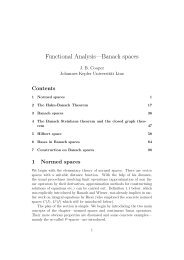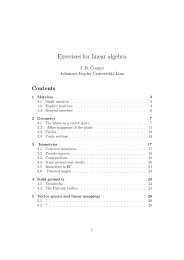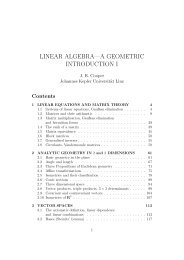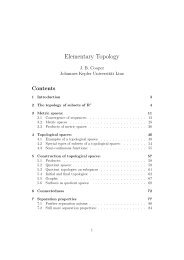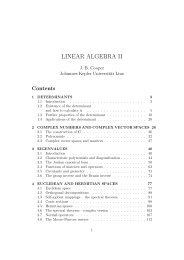Number theory, geometry and algebra - Dynamics-approx.jku.at
Number theory, geometry and algebra - Dynamics-approx.jku.at
Number theory, geometry and algebra - Dynamics-approx.jku.at
You also want an ePaper? Increase the reach of your titles
YUMPU automatically turns print PDFs into web optimized ePapers that Google loves.
Such forms s<strong>at</strong>isfy the rel<strong>at</strong>ion<br />
<strong>and</strong> as a result<br />
−d = 4ac−b 2 ≥ 3ac<br />
a ≤ 1 3 |d|, c ≤ 1 3 |d|, |b| ≤ 1 3 |d|.<br />
This implies th<strong>at</strong> there are <strong>at</strong> most finitely many reduced forms with a<br />
given diskriminant d. We write h(d) (the class number of d) for the number<br />
of reduced forms with diskriminant d.<br />
Example For d = −4 we have 3ac ≤ 4 <strong>and</strong> so a = c = 1 <strong>and</strong> b = 0. Hence<br />
h(−4) = 1.<br />
Theimportanceofthefunctionhliesinthefactth<strong>at</strong>ircountsthenumber<br />
of equivalent forms. Indeed we have<br />
Proposition 23 If f,g are reduced <strong>and</strong> d(f) = d(g), then f ∼ g.<br />
Proof. Weshallshowth<strong>at</strong>twodistinct reducedformf,g arenotequivalent.<br />
We begin with the remark th<strong>at</strong> |x| ≥ |y| implies:<br />
resp.<br />
f(x,y) ≥ |x|(a|x|−|by|)+c|y| 2 ≥ |x| 2 (a−|b|)+c|y| 2 ≥ a−|b|+c.<br />
f(x,y) ≥ a−|b|+c,<br />
if |y| ≥ |x|. Hence the three smallest values of f are a (for (1,0)), c (for<br />
(0,1)) <strong>and</strong> a−|b|+c (for (1,1) or (1,−1)). Hence a = a ′ , c = c ′ <strong>and</strong> b = ±b ′ ,<br />
where a ′ ,b ′ ,c ′ are the coefficients of g.<br />
We now show th<strong>at</strong> b = −b ′ implies b = 0. We can assume th<strong>at</strong> −a < b <<br />
a < c. (For −a < −b <strong>and</strong> a = c implies th<strong>at</strong> b ≥ 0 <strong>and</strong> −b ≥ 0, i.e. b = 0).<br />
In this case we have<br />
f(x,y) ≥ a−|b|+c > c > a.<br />
If we transform f into g by means of the m<strong>at</strong>rix P above, then a = f(p,r).<br />
Hence p = ±1 <strong>and</strong> r = 0. The condition ps − qr = 1 then implies th<strong>at</strong><br />
s = ±1. Further c = f(q,s) <strong>and</strong> so q = 0. This easily implies th<strong>at</strong> b = 0.<br />
Definition n is represented by f if x,y ∈ Z exists so th<strong>at</strong><br />
gcd (x,y) = 1, f(x,y) = n.<br />
Proposition 24 n is representable by a form f with discrimant d ⇔ the<br />
equ<strong>at</strong>ion x 2 = d(mod 4n) has a solution.<br />
34



